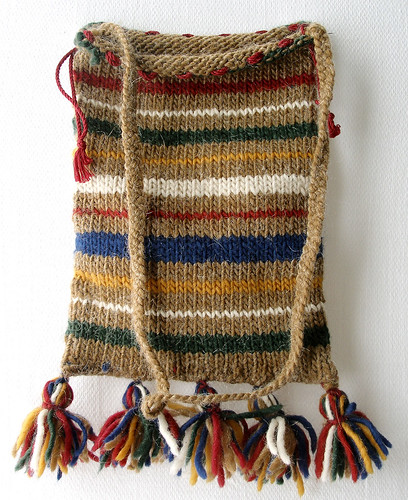New & improved pattern! (Download now from Ravelry)

This is my favorite project for a beginner’s class in knitting. It requires only that you be able to cast on, cast off, and knit — no purling required! The result is a simple bag that is useful in many ways.
NEEDLES
16-inch circular needle, U.S. size 5 or 6
(Optional: a set of double-pointed needles in the same size)
YARN
This bag takes about 2 ounces or 100 yards of worsted-weight yarn — the size most commonly used for sweaters.
Recommended yarns: Bartlett Yarns Fisherman 2-ply, Philosopher’s Wool 2-ply worsted, or another 2-ply 100% wool worsted-weight yarn would be the closest approximation to historical yarn from before 1600. To be most historically accurate, you want solid colors, with no light-to-dark or multicolor shading or heathering (these are later developments).
If you are doing stripes, you can use a few yards of any yarn in a color you like, as long as it’s the same thickness as your basic yarn. A one-row stripe all the way around takes about a yard.
Beginning at the top
Cast on 60 stitches. Join them into a round, being careful not to twist the row of stitches when you join it.
Knit plain (knit every stitch — no need to purl) until you think it’s long enough (8 inches is a good length).
After an inch or two, you may want to try putting your stitches onto 3 or 4 double-pointed needles, with one needle left free to work the stitches on each needle in turn. This was the method used for knitting in the round before circular needles were invented in the early 20th century.
STRIPES
If you want to try a small adventure and introduce some variety, take a length of colored yarn and at some point just start knitting your new stitches with that yarn instead. When you get around to your starting point again (1, or 2, or more rounds later) drop the new color and pick up your old yarn, being careful not to pull too tight and pucker the knitting. Repeat stripes at whatever interludes you like.
FINISHING
When finished, bind off, flatten the cylinder of knitting and overcast (sew) the two bound-off edges together at the bottom with a large needle and a strand of the same yarn (going once through each front & back stitch).
Alternatively, do a 3-needle bind-off to close the bottom of the bag (a common finish for closed ends before 1600).
If you changed colors, pull the beginning and ending of the colored yarn carefully so the stitches on the outside are the same size as all the other stitches. Take the loose end of yarn and, on the inside of the bag, weave it in and out a few times among other stitches of the same color and trim off the end.
Braid a carrying strap from leftover yarn (or any yarn you like). Sew it neatly onto the top of the bag at two opposite points. Cut or make two drawstrings — they work better if they are not wool. Shoelaces, smooth cotton string, and braided cotton embroidery thread work well. Thread both drawstrings in and out between the stitches in the third row from the top of the bag. Knot the two ends of each drawstring together. Pull one drawstring from each side to close the bag.
Simple bags like this often show up in medieval paintings with three to five tassels along the bottom.
MORE HISTORICAL BACKGROUND
For more information about historical knitting, download the pattern!
Text, page and photo copyright 2012 by Chris Laning. This pattern may be reproduced for nonprofit educational uses only; copies must include this notice. See the Creative Commons license icon in the right column for details. Please contact the author with any questions.


1 comment:
It's perfect for beginner's.
Thanks!!
Post a Comment